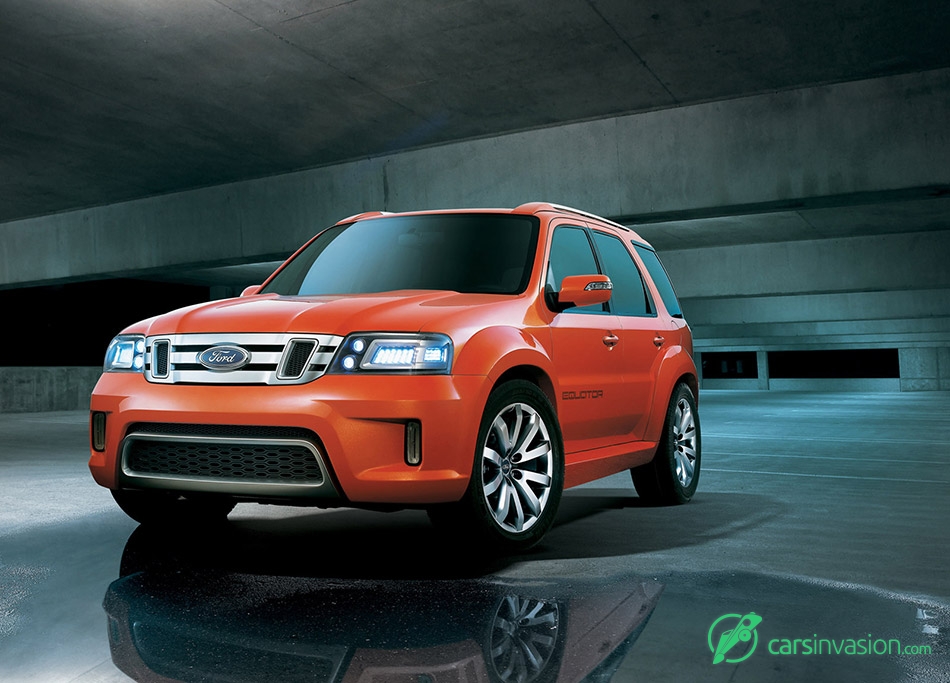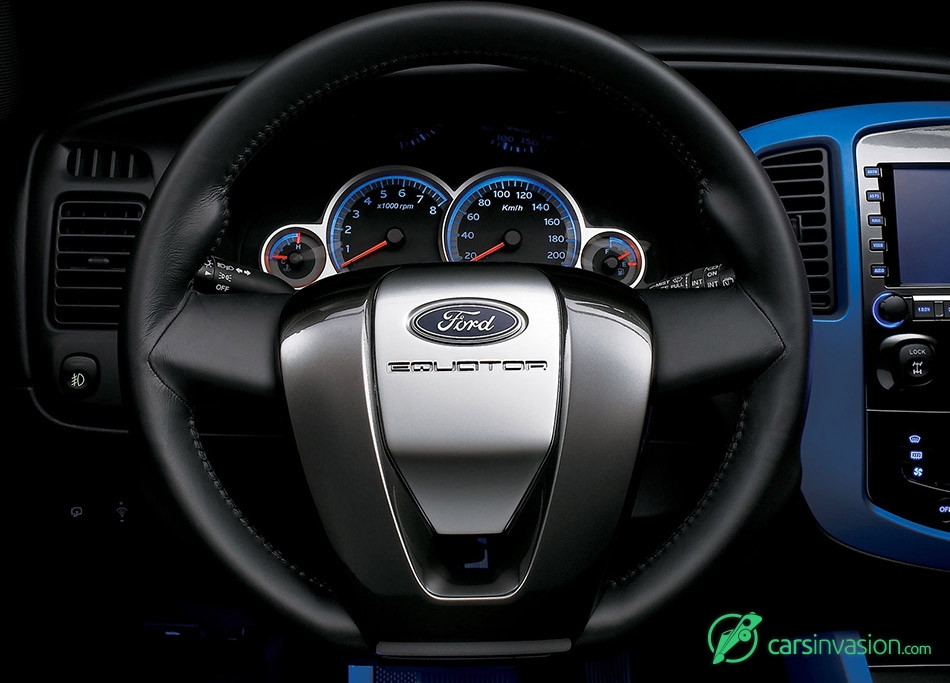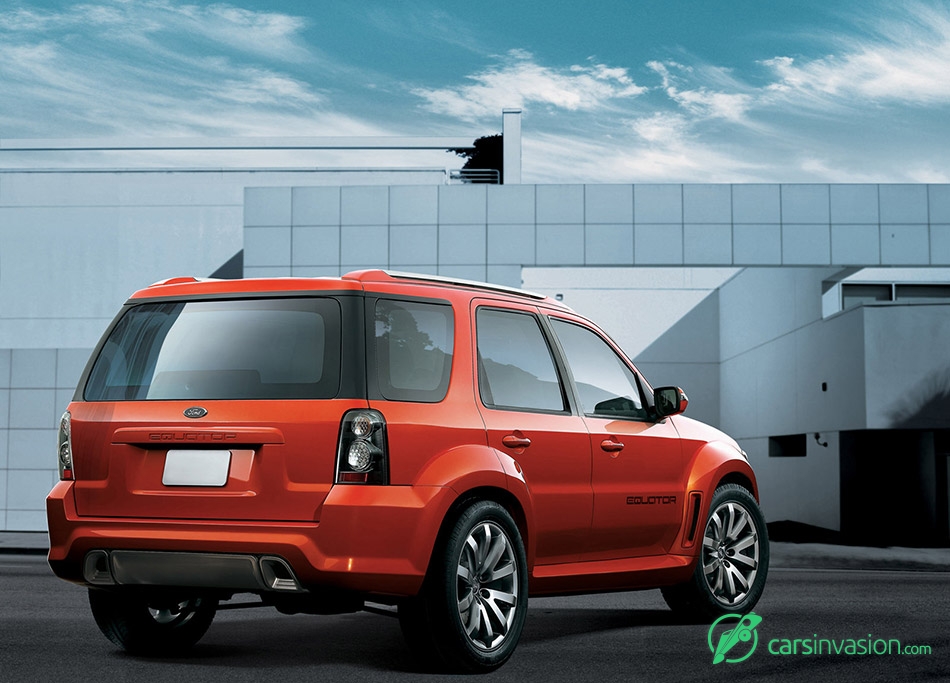In Japan, as in many countries throughout Asia, the Ford Escape is among the most well-known Ford products and a centrepiece of the company's customer acclaimed line up of SUVs. Known as the Maverick in China and other select market in Asia, the compact sport-utility vehicle was launched to customers in Asia in 2001 and is now among Ford's best-selling vehicles both in Japan and the Asia Pacific region.
The Escape/Maverick has always offered customers a nearly ideal mix of functionality and overall drivability—a small, sportier sport-utility vehicle (SUV) that provides the comfort and overall drivability customers demand for in-city driving while delivering the toughness and capability to perform equally well off-road. The four-door SUV offers good value in the market place, both affordable to purchase and economical to drive.

But with any good vehicle, there is always more to be had
This new Equator Concept offers a glimpse of the future for Ford compact SUVs, designed to make everyday seem like a weekend. The new concept was developed in Ford's Lio Ho Design Technology Center in Taipei, Taiwan.
The Equator Concept celebrates the more sporty side of Ford's best-selling small SUV and, in the words of Ford Asia Pacific and Africa Chief Design er Paul Gibson, "is certainly a lot more track than it is truck."
Exterior design anticipating a high-performance, sporty drive
The Equator Concept incorporates a new body trim that expressly demonstrates its athletic capabilities and aerodynamics. The new grille, with its enlarged air intake, and the new hood convey the visual appeal of the engine within. The sleek headlamps were developed working with the research and development team at TYC Brother Industrial.
The front end and new hood are complemented by well-defined body panels and a new skirt for the bodywork that visually lowers the vehicle and provides a more aerodynamic appearance. The Equator Concept's overall dimensions are: height 179.8 cm (70.8 inches); length 442.4 cm (174.2inches) and width 178.0 cm (70.1 inches). The wheelbase at 262.0 cm (102.4 inches) is unchanged from current Escape.
An aggressive, street-oriented wheel-and-tire package features 255/50R-19 Michelin tires and unique 10-spoke wheels with a "Chrome Shadow" finish composed of four unique layers of paint.
The design team chose a paint they named, "First Light Orange" for the show vehicle. The deep, bright color was chosen to replicate the colors of the sun rising over the open waters in the early morning hours on the Earth's equator.
Interior design: Four seats for fun
Like the Explorer, the Equator Concept's interior features a distinctively sporty design. The overall presence is modern, refined and flavored with visual cues that emphasize the sports car nature of this SUV. There is ample room for four, with driver and passengers alike riding in well-bolstered sport seats created by Ming Fong Industries, covered in a uniquely embossed PC Vinyl. The deep black surfaces were chosen to present a more hi-tech finish, creating a more upscale, premium feel.
The instrument panel features a digital compass below the in-dash DVD/Navigational system; a unique and new three-spoke GSK-supplied steering wheel; and an electronic gear-selection system that is activated with the push of a button and is slimmer and more refined looking than a traditional, center-mounted gearshift lever.
The interior of the car is bathed in a soft blue light that was chosen to best highlight the Cobalt Blue accents. The four-layer "Chrome Shadow" finish, similar to that used on the wheels, was also used on a number of interior surfaces.
Overall, the team worked closely with Taiwan-based XD Design Automotive & Industrial Design to deliver high levels of craftsmanship and quality, both visually and in substance. William Lee, manager of the Taipei design studio, notes, "The levels of interior quality that customers now expect—in even the most inexpensive cars—is higher than ever and each year the quality levels seem to go higher. We were very careful in our effort to select materials that add visual value to the interior, materials that consumers naturally connect with technology, innovation and precision machinery. We want a vehicle like the Equator Concept to compete closer to the premium segment, and one way to do that is through a sophisticated and well planned interior."

Powertrain: Sport On-Road and Off
As the Equator Concept is designed to deliver a sports performance, the development team selected a Duratec 30 engine—Ford's 24-valve, 3.0-liter V6. The engine features an aluminum block and heads, and dual overhead cams (DOHC). In the Equator Concept, the engine is tuned for 145 kW of power at 6,000 rpm with 265 lb-ft of torque at 4,700 rpm to match. The design team envisions power being sent through a six-speed computer-controlled automatic transmission.
The Equator Concept features a four-wheel-drive system that offers not only peace of mind in bad weather but also adds to the vehicle's overall performance, particularly in city driving and on dry pavement. The Intelligent 4WD System has a fully computer-controlled clutch that engages the rear wheels as needed. Under normal conditions, the Equator Concept is driven by its front wheels, but can transfer up to 99 percent of torque to the rear wheels as required. Using sensors at each wheel and the accelerator, the system's computer can calculate up to 200 times per second exactly how much torque to send to the rear wheels to minimize slip in difficult driving conditions. It can also predict wheel slip and preclude it from happening at all.
The Intelligent 4WD System eliminates one of the drawbacks of other four-wheel-drive systems that are tuned aggressively for maximum traction: a binding effect during tight turns often required while driving in the city and driveline harshness when the system engages. The Intelligent 4WD System can sense tight turns and continuously varies the torque to the rear wheels at all speeds, offering the benefits of a "locked" four-wheel-drive system without any of the drawbacks.
Stopping performance is handled by four-wheel 11.9-inch (30.2 cm) disc bakes in both the front and rear and the anti-lock brake system helps improve stopping performance in all driving conditions.
The Equator Concept's suspension is based on the current Escape system and features McPherson-type front struts with coil springs and an anti-roll bar. The rear of the vehicle features a multi-link setup system. The suspension for the Equator Concept is tuned to get the most out of the 19-inch Michelin tires and deliver premium performance on the street—performance in terms of both ride and handling, as well as passenger comfort. The Equator Concept's steering is a well-balanced and communicative power-assisted rack-and-pinion system.
An Asia Pacific Focus with Asia Pacific Intention
The Equator Concept showcar is the second concept developed by Ford's Asia Pacific and Africa design team, following on the successful Ford Focus Concept, which was unveiled at Auto China 2004 in Beijing. The Equator Concept is, likewise, developed for the Asia Pacific region and for the Japanese market specifically. As the Ford brand continues to grow in both mature and emerging markets in the region, the product development teams (including design, engineering, marketing and sales) understand the critical importance of delivering a consistent and focused line of vehicles that is clearly identified and associated with Ford—a line of vehicles that includes cars engineered in Europe and SUVs engineered in North America.
Dave Alden, Ford Asia Pacific and Africa's vice president of marketing, sales and service, said, "The Ford brand has always been about creating exciting, enduring vehicles that are within reach of the average consumer. Yes, Ford products are accessible and good value, but they should also be among the best in terms of design and driving dynamics. I think the Equator Concept featured at the Tokyo Motor Show 2005 shows consumers what we believe about the Ford brand. You have to ask yourself, 'How can you make every day of your life exciting?' At Ford, we believe having the right car is a good start."

The Origins of Equator Concept
The Equator Concept idea originated with Paul Gibson, who was named Chief Designer for Ford's Asia Pacific and Africa region in 2002. "I have always loved the vehicle's basic shape and proportions, I believe it is still a strong, fresh design in today's highly competitive market," Gibson notes. "However, I wanted to see what would happen if it were stretched in a new direction—if we took the 'sport' side of the vehicle and turned the volume up to the max."
The project began in January of 2005 and grew from a collection of simple design sketches that were developed to bring out the most of the donor vehicle's sporting nature, the 2005 Ford Escape. Over a period of about six months, Gibson worked with William Lee and his team at the Ford Design & Research Center in Taipei developing the vehicle theme and selecting the appropriate color and trim palette.
The real challenge Gibson, Lee and the design team faced was giving the Equator Concept a compact, low-slung sporty appearance while still retaining the overall functionality of the vehicle. While the vision was to produce a vehicle that is "more track than truck," the team could not entirely eschew the true appeal of sport-SUV: functionality.
"We think savvy consumers want it all," said Gibson. "They want all the functionality to haul their kit and gear, but they also want the look and feel of a sports car. They want a little performance and the visual appeal of a performance car. They want excitement - and what they drive should help deliver it," he said, adding that "we also worked to move the Equator Concept more upscale in an effort to attract more affluent customers, who are interested in sporty vehicles, but are not willing to sacrifice the SUV utility."
Source: Ford



















